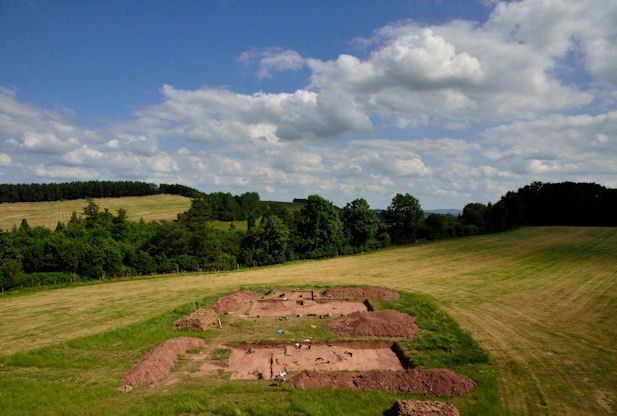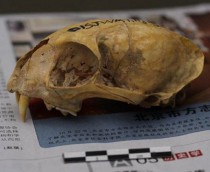Archaeologists from the University of Manchester and the Herefordshire Council have unearthed the remains of two large halls atop Dorstone Hill, near Peterchurch in Herefordshire, which are believed to have been constructed between 4000 and 3600 BC.
Some of the charred wood at the site shows the character of the structure of the buildings as they may have looked above ground. The researchers suggest these buildings were used by entire communities, but do not have enough information to determine how large each structure was. However, based on the length of the Neolithic-era barrows beneath each of the buildings, the researchers estimate the halls to have been 100ft. (30.48 m.) and 230 ft. (c. 70 m.) long, respectively.
The team also believes the buildings were deliberately burned down after construction and the remains of the buildings were incorporated into two unique burial mounds on the hilltop. Even though the halls were burned, much detail is still preserved in the larger barrow. The team has found carbonized structural timbers, postholes that offer positions of original uprights and the burnt remains of stakes of the internal partitions. Also, the burial mounds are composed of burnt clay, which implies the daub from the walls of the buildings was used in the burial process.
The smaller barrow was found to contain a 23-by-8-foot (7.1 x 2.4 m.) mortuary chamber with huge sockets that would have held upright tree trunks at each end. The massive posts “bracketed a linear ‘trough’ lined with planks, which would have held the remains of the dead.”
“This find is of huge significance to our understanding of prehistoric life — so we’re absolutely delighted,” noted Julian Thomas, Professor of archaeology at the University of Manchester, who co-directed the excavation.
“It makes a link between the house and a tomb more forcefully than any other investigation that has been ever carried out. These early Neolithic halls are already extremely rare, but to find them within a long barrow is the discovery of a lifetime. The mound tells us quite a bit about the people who built it: they sought to memorialize the idea of their community represented by the dwelling. And by turning it into part of the landscape, it becomes a permanent reminder for generations to come”, said Thomas.
“Just think of how the burning of the hall could have been seen for miles around, in the large expanse of what is now the border country between England and Wales,” he concluded.
Archaeologists have long held assumptions that there existed a close link between homes and tombs in Neolithic Europe, and have also speculated that ‘houses of the dead’ were similarly fashioned counterparts of the ‘houses of the living.’
Not only did the team uncover the two long burial mounds, but also had found evidence of later burials and deliberate deposits at the site, including a cremation burial and a pit containing a flint axe and a flint knife. The objects are similar to artifacts found in eastern Yorkshire in the Late Neolithic around 2600 BC.
“These subsequent finds show that 1000 years after the hall burial mounds were made, the site is still important to later generations living 200 miles away — a vast distance in Neolithic terms,” said Dr. Keith Ray, Herefordshire Council’s County Archaeologist, who also co-directed the excavation.
“The axe and knife may not have been traded, but placed there as part of a ceremony or an ancestral pilgrimage from what is now East Yorkshire,” he noted. “So we witness an interconnected community linking Herefordshire and East Yorkshire by marriage and by descent 5000 years ago.
“In the British context, the Dorstone find is unique and unprecedented,” he added. “We were hoping our work with The University of Manchester would help us to give us a clearer picture of the origins of these long barrows- but we were surprised how clearly the story came through.
“It’s very exciting for us: for 15 years I have been arguing that Herefordshire has something important to say on the national picture of our Neolithic heritage,” concluded Dr. Ray.




